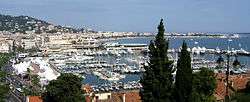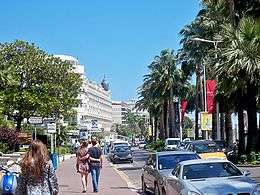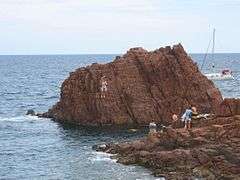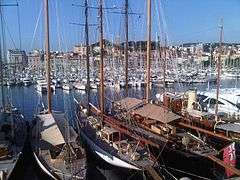Cannes
| Cannes, France | ||
|---|---|---|
|
| ||
| ||
 Cannes, France | ||
|
Location within Provence-A.-C.d'A. region  Cannes, France | ||
| Coordinates: 43°33′05″N 7°00′46″E / 43.5513°N 7.0128°ECoordinates: 43°33′05″N 7°00′46″E / 43.5513°N 7.0128°E | ||
| Country | France | |
| Region | Provence-Alpes-Côte d'Azur | |
| Department | Alpes-Maritimes | |
| Arrondissement | Grasse | |
| Government | ||
| • Mayor (2014-2020) | David Lisnard UMP | |
| Area1 | 19.62 km2 (7.58 sq mi) | |
| Population (2012)2 | 73,603 | |
| • Density | 3,800/km2 (9,700/sq mi) | |
| Time zone | CET (UTC+1) | |
| • Summer (DST) | CEST (UTC+2) | |
| INSEE/Postal code | 06029 / 06400 | |
| Elevation | 0–260 m (0–853 ft) | |
|
1 French Land Register data, which excludes lakes, ponds, glaciers > 1 km² (0.386 sq mi or 247 acres) and river estuaries. 2 Population without double counting: residents of multiple communes (e.g., students and military personnel) only counted once. | ||
Cannes (French: [kan], English /ˈkæn/, in Occitan Canas) is a city located on the French Riviera. It is a commune of France located in the Alpes-Maritimes department, and host city of the annual Cannes Film Festival, Midem, and Cannes Lions International Festival of Creativity. The city is known for its association with the rich and famous, its luxury hotels and restaurants, and for several conferences. On 3 November 2011 it also played host to the G20 organisation of industrialised nations.
History
By the 2nd century BC, the Ligurian Oxybii established a settlement here known as Aegitna (Αἴγιθνα in Ancient Greek). Historians are unsure what the name means. The area was a fishing village used as a port of call between the Lérins Islands.

In 69 AD, it became the scene of violent conflict between the troops of Otho and Vitellius.[1]
In the 10th century, the town was known as Canua.[2] The name may derive from "canna," a reed. Canua was probably the site of a small Ligurian port, and later a Roman outpost on Le Suquet hill, suggested by Roman tombs discovered here. Le Suquet housed an 11th-century tower which overlooked swamps where the city now stands. Most of the ancient activity, especially protection, was on the Lérins Islands and the history of Cannes is closely tied to the history of the islands.
An attack by the Saracens in 891, who remained until the end of the 10th century, devastated the country around Canua. The insecurity of the Lérins islands forced the monks to settle on the mainland, at the Suquet. Construction of a castle in 1035 fortified the city by then known as Cannes, and at the end of the 11th century construction was started on two towers on the Lérins islands. One took a century to build.
Around 1530, Cannes detached from the monks who had controlled the city for hundreds of years and became independent.
During the 18th century, both the Spanish and British tried to gain control of the Lérins Islands but were chased away by the French. The islands were later controlled by many, such as Jean-Honoré Alziary, and the Bishop of Fréjus. They had many different purposes: at the end of the 19th century, one served as hospital for soldiers wounded in the Crimean War.
Henry Brougham, 1st Baron Brougham and Vaux bought land at the Croix des Gardes and constructed the villa Eleonore-Louise. His work to improve living conditions attracted the English aristocracy, who also built winter residences.
At the end of the 19th century, several railways were completed, which prompted the arrival of streetcars. In Cannes, projects such as the Boulevard Carnot and the rue d'Antibes were carried out. After the closure of the Casino des Fleurs (hôtel Gallia), a luxury establishment was built for the rich winter clientele, the Casino Municipal next to the pier Albert-Edouard. This casino was demolished and replaced by the new Palace in 1979.
In the 20th century, new luxury hotels such as the Carlton, Majestic, Martinez, and JW Marriott Cannes were built. The city was modernised with a sports centre, a post office, and schools. There were fewer British and German tourists after the First World War but more Americans. Winter tourism gave way to summer tourism and the summer casino at the Palm Beach was constructed.
The city council had the idea of starting an international film festival shortly before World War II. The first opened on 20 September 1946, held in the Casino Municipal.
Climate
Cannes has a Mediterranean climate (Köppen climate classification Csa) and the city enjoys 12 hours of sunshine per day during summer (May to September), while in winter (December to February) the weather is mild. Both seasons see a relatively low rainfall and most rain occurs during October and November, when 110 mm (4.3 in) falls.
Cannes summers are long and warm, with summer daytime temperatures regularly hitting 30 °C (86 °F), while average temperatures are about 25 °C (77 °F). Temperatures remain high from June to September, the busiest time of the year.
Temperatures drop below 10 °C (50 °F) for only three months of the year (December to February). The spring and autumn are also warm, although more suited to those who prefer slightly cooler weather.
| Climate data for Cannes (1981–2010) | |||||||||||||
|---|---|---|---|---|---|---|---|---|---|---|---|---|---|
| Month | Jan | Feb | Mar | Apr | May | Jun | Jul | Aug | Sep | Oct | Nov | Dec | Year |
| Record high °C (°F) | 21.9 (71.4) |
26.0 (78.8) |
24.8 (76.6) |
27.6 (81.7) |
31.6 (88.9) |
34.7 (94.5) |
38.0 (100.4) |
37.0 (98.6) |
35.0 (95) |
31.0 (87.8) |
25.7 (78.3) |
23.4 (74.1) |
38.0 (100.4) |
| Average high °C (°F) | 13.1 (55.6) |
13.5 (56.3) |
15.7 (60.3) |
17.3 (63.1) |
21.0 (69.8) |
24.5 (76.1) |
27.5 (81.5) |
27.8 (82) |
24.8 (76.6) |
20.9 (69.6) |
16.7 (62.1) |
13.9 (57) |
19.7 (67.5) |
| Daily mean °C (°F) | 8.4 (47.1) |
8.7 (47.7) |
10.8 (51.4) |
13.0 (55.4) |
16.9 (62.4) |
20.5 (68.9) |
23.2 (73.8) |
23.4 (74.1) |
20.2 (68.4) |
16.6 (61.9) |
12.3 (54.1) |
9.2 (48.6) |
15.3 (59.5) |
| Average low °C (°F) | 3.6 (38.5) |
3.9 (39) |
6.2 (43.2) |
8.7 (47.7) |
12.8 (55) |
16.4 (61.5) |
18.8 (65.8) |
18.8 (65.8) |
15.5 (59.9) |
12.3 (54.1) |
7.8 (46) |
4.6 (40.3) |
10.8 (51.4) |
| Record low °C (°F) | −12 (10) |
−8.6 (16.5) |
−9.9 (14.2) |
−0.5 (31.1) |
2.3 (36.1) |
7.4 (45.3) |
8.8 (47.8) |
10.5 (50.9) |
5.3 (41.5) |
0.9 (33.6) |
−3 (27) |
−5.6 (21.9) |
−12 (10) |
| Average precipitation mm (inches) | 76.7 (3.02) |
41.9 (1.65) |
41.9 (1.65) |
72.5 (2.854) |
49.4 (1.945) |
30.9 (1.217) |
16.0 (0.63) |
24.6 (0.969) |
79.6 (3.134) |
120.1 (4.728) |
107.0 (4.213) |
95.6 (3.764) |
756 (29.76) |
| Average precipitation days (≥ 1.0 mm) | 5.80 | 4.80 | 4.97 | 6.53 | 5.17 | 3.73 | 1.83 | 2.77 | 4.43 | 7.03 | 7.20 | 6.50 | 60.8 |
| Average relative humidity (%) | 72 | 70 | 70 | 70 | 73 | 74 | 72 | 72 | 74 | 75 | 74 | 72 | 72.3 |
| Mean monthly sunshine hours | 152.3 | 175.3 | 225.4 | 225.3 | 265.3 | 311.5 | 343.2 | 316.0 | 254.6 | 193.5 | 148.3 | 133.8 | 2,750 |
| Source #1: Meteo climat[3][4] | |||||||||||||
| Source #2: Infoclimat.fr (humidity 1961–1990)[5] | |||||||||||||


Economy

The area around Cannes has developed into a high-tech cluster. The technopolis of Sophia Antipolis lies in the hills beyond Cannes. The Film Festival is a major event for the industry. There is an annual television festival in the last week in September.
The economic environment is based on tourism, business fairs, trade and aviation. Cannes has 6,500 companies, of which 3,000 are traders, artisans and service providers. In 2006, 421 new companies were registered.
Cannes hosts the Cannes Mandelieu Space Center, headquarters of Thales Alenia Space, the first European satellite manufacturer.
Landmarks
The Promenade de la Croisette is the waterfront avenue with palm trees. La Croisette is known for picturesque beaches, restaurants, cafés and boutiques. Le Suquet, the old town, provides a good view of La Croisette. The fortified tower and Chapel of St Anne house the Musée de la Castre. A distinctive building in Cannes is the Russian Orthodox church.
Museums
The Musée d'Art et d'Histoire de Provence houses artifacts from prehistoric to present, in an 18th-century mansion. The Musée de la Castre has objects from the Pacific Atolls, Peruvian relics and Mayan pottery. Other venues include the Musée de la Marine, Musée de la Mer, Musée de la Photographie and Musée International de la Parfumerie.
The villas of Cannes
Cannes of the 19th century can still be seen in its grand villas, built to reflect the wealth and standing of their owners and inspired by anything from medieval castles to Roman villas. They are not open to the public. Lord Brougham’s Italianate Villa Eléonore Louise (one of the first in Cannes) was built between 1835 and 1839. Also known as the Quartier des Anglais, this is the oldest residential area in Cannes. Another landmark is the Villa Fiésole (known today as the Villa Domergue) designed by Jean-Gabriel Domergue in the style of Fiesole, near Florence, which may be visited on appointment.
Île Sainte-Marguerite (St Marguerite Island)
It took the Man in the Iron Mask 11 years to leave this tiny, forested island. The mysterious individual was believed to be of noble blood, but his identity has never been proven. His cell can be visited in the Fort of St Marguerite, now renamed the Musée de la Mer (Museum of the Sea). This museum also houses discoveries from shipwrecks off the island, including Roman (1st century BC) and Saracen (10th century AD) ceramics.
Île Saint-Honorat (St Honorat Island)
Cistercian monks are the only inhabitants of the smaller, southern St Honorat Island. Monks have inhabited the island since AD 410 and, at the height of their powers, owned Cannes, Mougins, and Vallauris. Medieval vestiges remain in the stark church, which is open to the public, and in the ruins of the 11th-century monastery on the sea shore. The monks inhabit the Lérins Abbey and divide their time between prayer and producing red and white wines.
Theatre and music
Cannes is not renowned for traditional theatre. However, small venues stage productions and host short sketches during the annual International Actors’ Performance Festival. Popular theaters include the Espace Miramar and the Alexandre III.
Festivals and show events
- The Cannes Film Festival founded in 1946 is held annually, usually in May, at the Palais des Festivals et des Congrès.
- The Cannes Lions International Festival of Creativity is a global event and awards show for those working in advertising and related fields, held annually in June.
- Midem, the foremost trade show for the music industry.
- MIPIM, the world's largest property-related trade show.
- Carnival on the Riviera is an annual parade through the streets to mark the 21-day period prior to Shrove Tuesday.
- The International Festival of Games is festival of bridge, belote, backgammon, chess, draughts, tarot and more (February).
- Cannes Yachting Festival is an event for boating enthusiasts in the Vieux Port (September).
- The International Actors’ Performance Festival: comedy sketches and performances by fringe artists
- The International Luxury Travel Market brings together under one roof the top international luxury travel providers and suppliers from all around the world.
- Le Festival d’Art Pyrotechnique is a magnificent annual fireworks competition held in the summer at the Bay of Cannes.
- The[Global Champions Tour]showjumping league has an annual event in the ports of Cannes.
- Mipcom and MIPTV, held in October and April respectively, the world's most important trade markets for the television industry.
- The Pan-African Film Festival, held in early April and featuring films from the African diaspora.
Transport
- Nice Côte d’Azur Airport
Located 24 km (15 mi) from Cannes, Nice Côte d’Azur Airport has close to 10 million passengers a year. Marseille Provence Airport is also 150 km (93 mi) away. The smaller Cannes – Mandelieu Airport is nearby. CannesExpress operate a regular door-to-door airport shuttle service between Nice Airport and hotels/accommodations in Cannes. Price per seat is 20 Euros.
- Rail
TGV rail services to the Gare de Cannes provide access from major French cities, including Nice, Marseille, Lyon, Paris, and Toulouse. Other cities with rail connections include Brussels (6 hours), Milan (5 hours), Basel (10 hours), Rome (10 hours), and Venice (10 hours). The minor train stations Gare de Cannes-La Bocca and Gare du Bosquet serve only regional destinations.
- Bus
Coach services arrive at the Gare Routière de Cannes, in the centre of the city, near the Town Hall. Companies from abroad include Eurolines and Agence Phoceens. Regional services are by Rapides Côte d’Azur and CTM, with services from Nice and Grasse/Mandelieu respectively. Local bus services are provided by Bus Azur.
- Ferry
Ferries are available in Nice harbour from Bastia and Calvi in Corsica, with services provided by SNCM Ferryterranée and Corsica Ferries. From Bastia, the journey is 4 hours, 45 minutes on conventional ferries and 3 hours, 40 minutes on express ferries, while from Calvi, conventional vessels take 3 hours, 45 minutes and express vessels take 2 hours, 45 minutes. An average of four ferries a day sail on these routes, with more during summer.

International relations
Twin towns – Sister cities
Cannes is twinned with:
|
Cannes has friendship pacts with:
Sons and daughters of the town
- Paolo Barzman (born 1957), French-American film director
- Yann Bonato (born 1972), basketball player
- Sarah Bouhaddi (born 1986), football player
- Jean-Jacques Kantorow (born 1945), violinist and conductor
- Brandon Maïsano (born 1993), racing driver
- Johan Micoud (born 1973), football player
- Anthony Modeste, (born 1988), football player
- Gérard Philipe (1922-1959), theater and film actor
- Anne Spoerry (1918-1999), French-Kenyan doctor and pilot
Gallery
 Aerial view of Cannes
Aerial view of Cannes The marina at Cannes
The marina at Cannes The Croisette gardens
The Croisette gardens St Honorat Island
St Honorat Island Hôtel de Ville (The City Hall)
Hôtel de Ville (The City Hall) The rocky beaches in Cannes
The rocky beaches in Cannes The old harbour
The old harbour Cannes by night
Cannes by night
See also
References
- ↑ Reported in Polybius, Histories, 33.10.
- ↑ Meeks, Jacqueline Monsigny, Edward (2007). Le roman du festival de Cannes (in French). Monaco: Rocher. p. 19. ISBN 2268061930.
- ↑ "Moyennes 1981/2010: Région Provence-Alpes-Côte d'Azur" (in French). Météoclimat. Retrieved December 19, 2014.
- ↑ "STATION Cannes" (in French). Météoclimat. Retrieved December 19, 2014.
- ↑ "Normes et records 1961-1990: Cannes - Mandelieu (06) - altitude 2m" (in French). Infoclimat. Retrieved December 19, 2014.
- ↑ "British towns twinned with French towns [via WaybackMachine.com]". Archant Community Media Ltd. Archived from the original on 5 July 2013. Retrieved 2013-07-20.
- ↑ "International Exchange". List of Affiliation Partners within Prefectures. Council of Local Authorities for International Relations (CLAIR). Retrieved 21 November 2015.
- ↑ Pessotto, Lorenzo. "International Affairs - Twinnings and Agreements". International Affairs Service in cooperation with Servizio Telematico Pubblico. City of Torino. Archived from the original on 18 June 2013. Retrieved 2013-08-06.
Further reading
- Published in the 19th century
- "Cannes", A Handbook for Travellers in France (8th ed.), London: J. Murray, 1861
- C. B. Black (1896), "Cannes", The Riviera; or, the Coast from Marseilles to Leghorn (9th ed.), London: Adam & Charles Black
- Published in the 20th century
- "Cannes", The Encyclopaedia Britannica (11th ed.), New York: Encyclopaedia Britannica, 1910, OCLC 14782424
- "Cannes", Southern France, including Corsica (6th ed.), Leipzig: Baedeker, 1914
External links
| Wikimedia Commons has media related to Cannes. |
| Wikivoyage has a travel guide for Cannes. |
| Wikisource has the text of the 1911 Encyclopædia Britannica article Cannes. |
- Cannes at DMOZ (English)
- Information and photos from Provence Beyond web site
- The City Hall official website (French)
- Cannes Tourist Office official website (English)
- Cannes Film Festival official website (French) (English)
- News site for travellers to Cannes (English)
- Cannes Webcam (English)
- Panoramic virtual tour of the Cannes seafront
- Photos, videos, paintings of Cannes and Cannes film festival (french/english and more)
.jpg)
.svg.png)